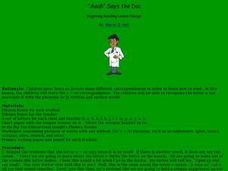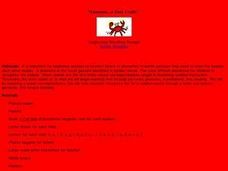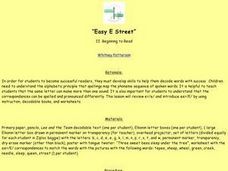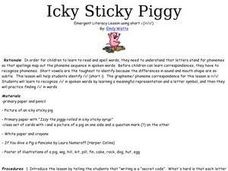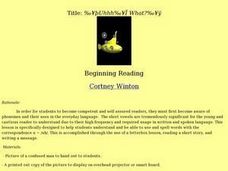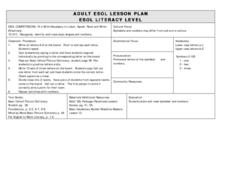Curated OER
"Aaah" Says the Doc
Students complete a variety of activities as they explore/review the letter 'o' as it makes the short /o/ sound. They recite short /o/ tongue twisters, practice writing the letter 'o', and listen to stories, identifying words with the...
Curated OER
Icky Sticky Inchworm
Students examine the letter 'i'. Through instruction and modeling they explore the sound the letter makes, how the letter is written, words that contain the letter, etc. They use letterboxes to write 'i' words and read stories containing...
Curated OER
"Aaaaaaa...a Fast Crab! "
Students participate in an emergent literacy lesson that focuses on the skill of phonemic awareness. The phoneme chosen is the letter "a". They need to correlate the sound to the letter.
Curated OER
The Struggle to Organize
Students analyze correspondence and a news release regarding the Harlan, Kentucky, mine strike of 1931-1932. They use these documents to discuss the problems of organizing industrial trade unions before the New Deal.
Curated OER
Pop, Pop, Popcorn
Students study the letter 'p' in both written and spoken word. They practice making the /p/ sound before reciting a tongue twister and writing the letter. Next, they listen to a read aloud of Charles Pomerantz, "Piggy in the Puddle"...
Curated OER
Beginning Reading Lesson: Aaa-aaa-aaa-choo!!
Pupils study the letter sound recognition for the /a/ by recognizing the sound one makes when they sneeze. They use a chart with a tongue twister on it and work with letterboxes and manipulative letters that focus on words with the /a/....
Curated OER
E-E-E-E-Extra E-E-E-E-Effort
Students listen to a tongue twister emphasizing the short e sound. They practice writing the letter e and attaching different words with that sound to it. They listen to a book about a dog that enhances the letter e. They write a...
Curated OER
"Easy E Street"
Students investigate how the same letter can make more than one sound. It is also important for students to understand that the correspondences can be spelled and pronounced differently. This lesson will review e=/e/ and introduce ee=/E/...
Curated OER
AAA!! The Baby is Crying! AAA!!
First graders take out primary writing paper and review how to form the letter "a". They observe a large picture of a baby crying on the board, discuss it and make the sound a baby makes when it is crying. They listen to some words,...
Curated OER
Icky Sticky Piggy
Students examine the letter 'i' and the short /i/ sound. Through instruction and modeling they explore how to make the short /i/ sound, how the letter 'i' is written, etc. They recite tongue twisters and read stories and pick out words...
Curated OER
Uhhh..What?
Students identify and become competent and in reading the letter u, pronounced /uh/. They also use and spell words with the correspondance u = /uh/ by the use of a letterbox instructional activity, reading a short story, and writing a...
Curated OER
A Tisket-A-Tasket, Let?s Make a Flower Basket!!!
First graders practice blending words with the phonemes /i/ and /e/. Working with a specific groups of letters, 1st graders create words using the vowels i and e. they decode those words and read them repeatedly to increase fluency.
Curated OER
Language Arts: Sound Recognition
First graders practice the short i sound by repeating tongue twisters. Later they write the letter i by using the analogy of drawing a straight line from the "fence" down to the "sidewalk" and putting a "basketball" above it. Other...
Curated OER
Aaaaa! I'm at the Doctor
Students develop Phoneme awareness of a letter. They explore pictures, hand gestures, tongue twisters, and sounding out the letter. The i will be represented through a picture of an i and students circle the words with the...
Curated OER
ESOL Basic numbers and SHapes
Students review then recognize the letters A-Z both uppercase and lowercase and the numbers 0-100. They practice letters orally then play a letter writing game and number game as a class.
Curated OER
"Tick, Tock," Says the Clock!
Students explore the letter 't' and the /t/ sound. Through instruction and modeling they practice writing uppercase and lowercase T's. They say 't' tongue twisters. They identify 't' words on a worksheet and as they are read aloud from a...


